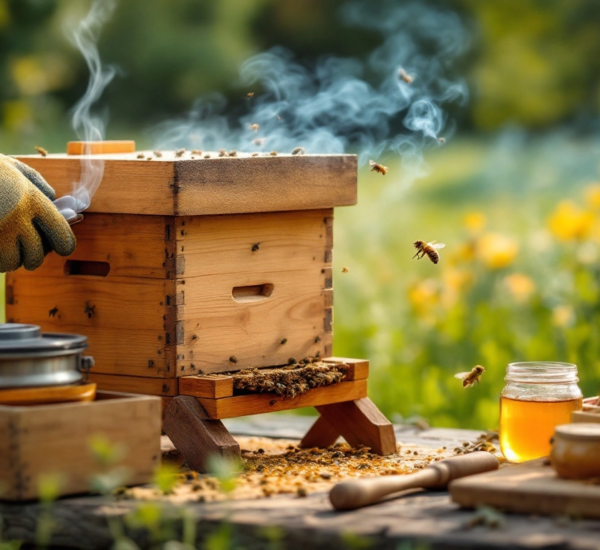Do you dream of keeping bees but feel limited by your small space? Urban lifestyles are rapidly evolving, and with them comes the creative reimagination of traditional hobbies. Beekeeping, once associated with sprawling gardens and countryside orchards, is now finding a niche on apartment balconies, rooftops, and compact urban backyards. Thanks to small-space beekeeping tips and innovative compact hive designs, you can enjoy the joys of beekeeping regardless of how limited your outdoor area is. In this article, we’ll explore the best hives for small spaces and practical tips to manage urban beekeeping. Let’s get buzzing!
Table of Contents
- Why Small-Space Hives Are Perfect for Urban Beekeeping
- Top Compact Beehive Designs for Limited Spaces
- Small-Space Beekeeping Tips for Success
- Balcony Beekeeping Essentials and Challenges
- Managing Urban Hives Effectively
- FAQs About Small-Space Hives
Why Small-Space Hives Are Perfect for Urban Beekeeping
Benefits of Beekeeping in Small Spaces
Urban beekeeping is more than a trend—it’s a way to enrich city living while supporting local ecosystems. Compact hives offer a cost-effective, sustainable option for hobbyists without sprawling green spaces. Beyond honey production, bees contribute to pollination, boosting nearby community gardens and urban greenery. With proper planning, even the smallest space can host a hive that positively impacts the environment and your lifestyle.
How Small-Space Hive Solutions Meet Growing Urban Needs
As city living becomes increasingly compact, beekeeping gear has adapted to fit urban needs. Compact beehives, designed for tight setups, optimize productivity without sacrificing bee welfare. Advances in technology make it easier to manage hives in confined areas while ensuring accessibility for beginners. Read more about urban beekeeping trends and technology here.
Top Compact Beehive Designs for Limited Spaces
Popular Hive Models for Tight Spaces
Some hives are naturally suited for compact settings. The Langstroth hive, commonly used by beekeepers worldwide, can be customized for a smaller footprint. The Warré hive is another favorite, thanks to its vertical stack design that maximizes space while maintaining simplicity. Learn more about the types of beehives and their uses here.
Innovative Modern Designs
In urban settings, modern designs like Flow Hives are gaining traction. These hives allow hassle-free honey extraction without interrupting the bees, making them ideal for balconies and rooftops. Another option is observation hives, which combine function and aesthetics—perfect for hybrid indoor/outdoor setups. Check out some reviews of modern beehives here.
How to Choose the Best Hive for Small-Space Beekeeping
When choosing a hive, consider three key factors: space, climate, and your experience level. Look for a balance between compactness and productivity. Avoid overly complex setups if you’re a beginner; instead, opt for user-friendly designs that fit your unique living situation.
Small-Space Beekeeping Tips for Success
Setting Up Your Hive
Start by choosing an ideal location for your hive. Prioritize areas with direct sunlight, easy accessibility for inspections, and minimized exposure to noise and disturbances. A stable, durable platform is essential for urban setups, especially on rooftops or balconies.
Maintaining Healthy Bees in a Limited Space
Overcrowding can be a challenge for compact beekeepers. Regular hive inspections and maintenance checks are necessary to prevent swarming and manage pests effectively. Proper pest control protocols, such as using screened bottom boards, can go a long way in compact setups.
Legal Practices and Beekeeping Etiquette in Urban Areas
Before embarking on your urban beekeeping adventure, familiarize yourself with local regulations. Some cities require permits or restrict the number of hives per property. Additionally, maintaining good relationships with neighbors by educating them about the benefits of your hive can foster a harmonious environment. Discover legal tips for city beekeepers here.
Balcony Beekeeping Essentials and Challenges
Why Balconies Are Ideal for Beekeeping
Apartments with balconies offer a unique opportunity to engage in beekeeping. Hives placed here are often in close proximity to flowering plants and urban green spaces. Their compact frames make them an easy fit for balcony setups without being intrusive.
Key Challenges of Balcony Beekeeping
One of the main challenges of balcony beekeeping is space management. Safety concerns regarding bee behavior and interactions with neighbors or passersby must also be considered. Additionally, intensifying heat in such small setups can create environmental stress for your colony.
Solutions for Common Balcony Beekeeping Problems
Simple solutions can address most balcony beekeeping obstacles. For instance, providing a small water source and ample shade during hotter months will help your colony thrive. Using netting or barriers can ensure better containment and protect neighbors’ privacy.
Managing Urban Hives Effectively
Monitoring Hive Health in Urban Environments
Track your colony’s health with regular inspections. Urban factors like pollution or noise may influence bee behavior, so keeping a close eye on their productivity is critical to ensuring a thriving hive.
Maximizing Honey Production in Small Hives
With the right seasonal care, small hives can yield surprising amounts of honey. Compact honey-extraction systems, such as Flow Hive designs, allow efficient harvesting directly from the hive without disrupting the bees.
Expanding Your Beekeeping Hobby
Over time, you may want to grow your urban beekeeping hobby by introducing additional hives or mentoring other aspiring beekeepers. The positive contributions you make to urban biodiversity can inspire an entire community. Discover how beekeeping impacts biodiversity here.
Frequently Asked Questions
What are the best hives for small spaces, and how do they compare?
The best options are Langstroth, Warré, and Flow Hives. Each has unique benefits: Langstroths are versatile, Warrés are compact, and Flow Hives simplify honey harvesting.
Can I keep bees on my apartment balcony?
Yes! Ensure safety, compliance with local regulations, and choose compact hive designs like Warré or observation hives for best results.
How do I prevent overcrowding in compact beehives?
Overcrowding can be prevented with regular hive inspections. Splitting an intense hive or providing ample space within your setup are effective methods.
Conclusion
Small-space beekeeping transforms limited urban spaces into thriving, sustainable oases for bees and your community. Whether you’re using a balcony, rooftop, or backyard, compact hive designs and careful management make urban beekeeping a rewarding hobby. Ready to start your journey? Discover more with our Beginner’s Guide to Beekeeping. Let’s make the city buzz with life!




